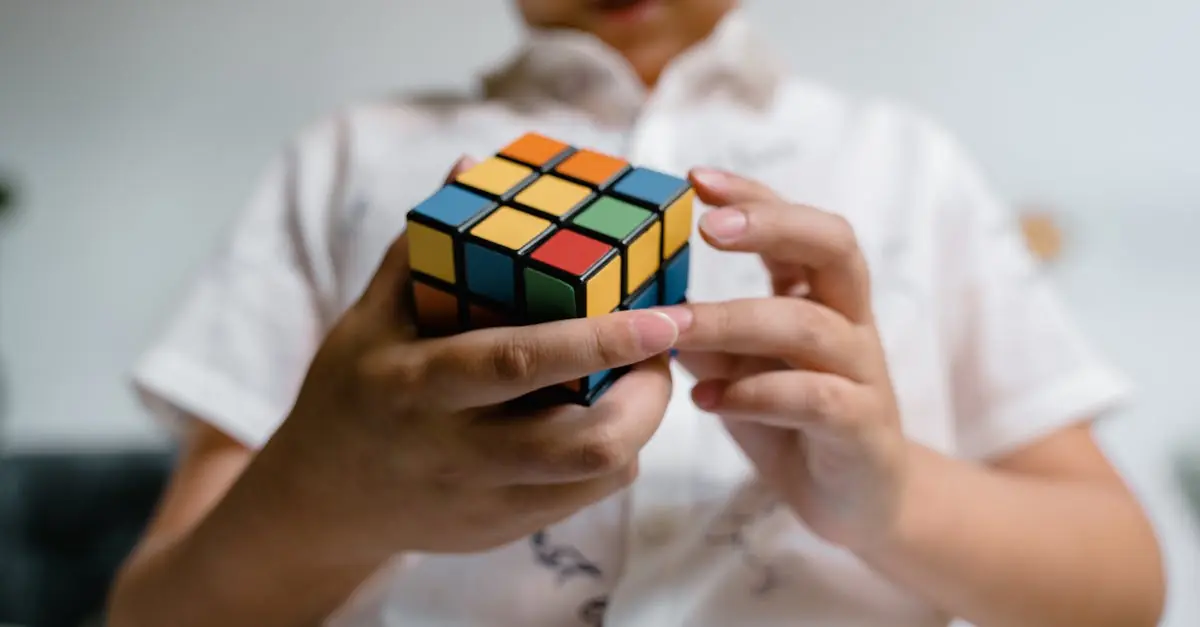In a world that often feels like it’s running on autopilot, creative thinking is the rocket fuel that can launch ideas into orbit. It’s not just about doodling in the margins of a meeting agenda; it’s the secret sauce that turns mundane problems into exciting opportunities. Whether you’re brainstorming a new marketing campaign or trying to impress your in-laws with a unique dinner recipe, harnessing this skill can make all the difference.
Imagine having the ability to see connections where others see chaos. Creative thinking isn’t just for artists or inventors; it’s a vital tool for anyone looking to stand out in today’s fast-paced environment. So buckle up and get ready to explore how sharpening this skill can transform not just your work, but also your everyday life. After all, who wouldn’t want to be the genius who finds the next big idea while waiting in line for coffee?
Table of Contents
ToggleUnderstanding Creative Thinking Skill
Creative thinking skill represents the ability to approach situations with a novel perspective. It encourages innovative ideas and solutions across various contexts.
Definition of Creative Thinking Skill
Creative thinking skill involves thinking outside traditional boundaries. This skill encompasses generating unique ideas, concepts, and solutions. It requires flexibility in thought processes and a willingness to explore unconventional approaches. Problem-solving enhances with creative thinking, enabling individuals to view challenges from multiple angles. For example, brainstorming sessions in team environments often showcase diverse perspectives that lead to unexpected solutions. Overall, creative thinking acts as a foundation for innovation, linking critical thinking with imagination.
Importance in Daily Life
Creative thinking skill plays a vital role in daily life and decision-making. Enhancing this skill can boost problem-solving capabilities in both professional and personal arenas. Individuals equipped with creative thinking often find new ways to tackle obstacles that arise unexpectedly. Studies show that organizations valuing creativity outperform competitors, adapting quickly to market changes. Additionally, creativity nurtures emotional intelligence, fostering better communication and collaboration within teams. Everyday situations, like planning an event or resolving conflicts, also benefit from creative approaches, transforming routine tasks into engaging endeavors.
Key Components of Creative Thinking Skill
Creative thinking consists of several key components that enhance an individual’s ability to generate innovative ideas and solutions. Two main aspects are divergent thinking and convergent thinking.
Divergent Thinking
Divergent thinking refers to the ability to generate multiple ideas or solutions in response to a problem. This type of thinking encourages individuals to explore various possibilities without immediately judging their viability. Flexibility plays a critical role in this process, allowing a person to approach problems from different angles. Brainstorming sessions often illustrate divergent thinking, where teams produce a wide array of ideas rapidly. This component contributes significantly to creativity, as it fosters an environment where unique and innovative thoughts can emerge.
Convergent Thinking
Convergent thinking, on the other hand, involves narrowing down multiple ideas or solutions to identify the most effective one. This type of thinking requires critical evaluation and logical reasoning to assess options based on specific criteria. Individuals practicing convergent thinking analyze their ideas systematically, focusing on feasibility and practicality. Often, this component is crucial when making decisions in creative projects. By combining both divergent and convergent thinking, individuals can enhance their creative processes, seamlessly transitioning from idea generation to decision-making.
Techniques to Enhance Creative Thinking Skill
Enhancing creative thinking involves utilizing specific techniques that spark innovative ideas. Two of the most effective methods include brainstorming and mind mapping.
Brainstorming
Brainstorming encourages individuals to generate numerous ideas quickly. Participants share thoughts freely, creating an open atmosphere where all contributions are valued. This unstructured approach fosters creativity by allowing spontaneous connections between ideas. Groups or individuals can set a timer for focused sessions, stimulating a sense of urgency and pushing boundaries. Following the session, evaluating and refining the ideas helps identify the most promising solutions. Research reveals that diverse groups often yield better results, as varied perspectives contribute to richer discussions.
Mind Mapping
Mind mapping provides a visual framework to organize thoughts. Central concepts branch out into related ideas, creating a clear structure. This technique enhances understanding and retention of information. Individuals can start with a core theme and expand by adding keywords or images, illustrating connections effectively. Mind maps allow for easy revisions as new ideas emerge. Studies show that visual learners often benefit significantly from this method, improving their ability to generate solutions creatively. By revisiting and modifying maps, individuals can explore and refine ideas continuously.
Real-World Applications of Creative Thinking Skill
Creative thinking plays a significant role in various settings, from education to the workplace. This skill enhances not just individual performance but also fosters collaboration and innovation.
In Education
Creative thinking in education cultivates a dynamic learning environment. Students benefit from exploring various approaches to problem-solving, engaging with course material in unique ways. Encouraging creativity fosters critical thinking, helping students connect concepts across disciplines. Teachers who implement creative teaching strategies often see higher levels of student engagement. Group projects allow learners to share diverse perspectives, enhancing collaborative skills. Ultimately, educational institutions that prioritize creative thinking equip students with tools for future success.
In the Workplace
Creative thinking empowers employees to tackle challenges effectively. Companies that foster a creative culture experience increased innovation and adaptability. Employees who apply creative skills contribute to brainstorming sessions that generate new ideas. Integrating diverse viewpoints in teams leads to robust solutions and improved product development. Organizations that value creativity often experience higher employee satisfaction and retention rates. Emphasizing creative thinking transforms workplace dynamics, leading to a more motivated and resourceful workforce.
Challenges in Developing Creative Thinking Skill
Creative thinking encounters various challenges that can hinder its development. Understanding these obstacles is essential for fostering a more innovative mindset.
Common Barriers
Environments that discourage risk-taking often stifle creative thought. Fear of criticism can prevent individuals from sharing unique ideas. Rigid structures and conventional practices may limit exploration of alternative solutions. Time constraints also play a significant role, as busy schedules can prioritize immediate tasks over long-term creative processes. Additionally, lack of collaboration within teams inhibits diverse perspectives, leading to a narrow approach to challenges.
Overcoming Obstacles
Building a supportive environment encourages risk-taking and openness to new ideas. Teams can create safe spaces for sharing thoughts without fear of judgment. Allocating time for brainstorming sessions allows individuals to engage in creative processes without pressure. Diversifying groups fosters an exchange of various viewpoints, enhancing overall creativity. Furthermore, integrating creative exercises into daily routines helps reinforce this skill, transforming obstacles into opportunities for growth.
Embracing creative thinking skills unlocks a world of possibilities. By fostering an innovative mindset individuals can navigate challenges with ease and turn obstacles into opportunities. The ability to think creatively not only enhances personal growth but also drives success in professional environments.
Organizations that prioritize creativity cultivate a dynamic culture where collaboration thrives. This leads to improved problem-solving and adaptability in a rapidly changing landscape. As individuals and teams develop their creative thinking capabilities they pave the way for groundbreaking ideas and solutions.
Ultimately investing in creative thinking is investing in a brighter future. It empowers individuals to approach life with curiosity and openness transforming everyday experiences into extraordinary adventures.

